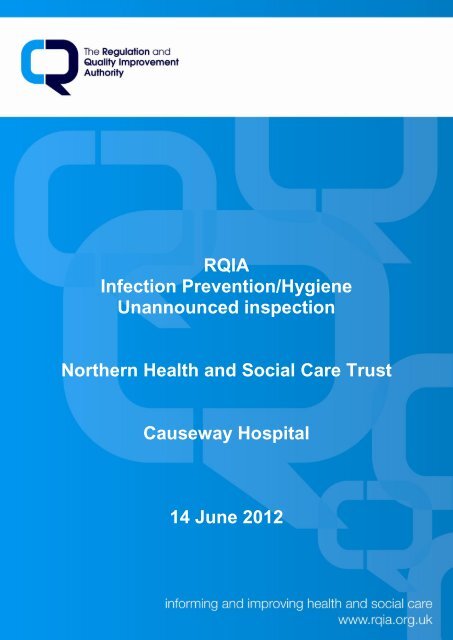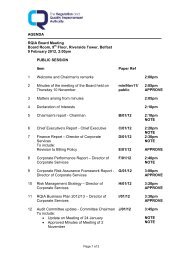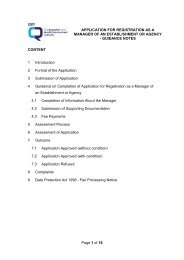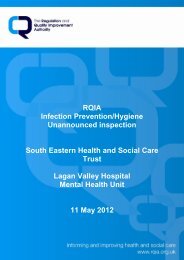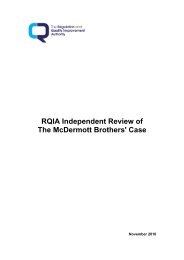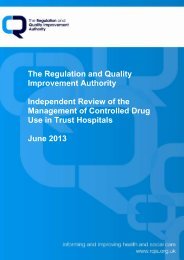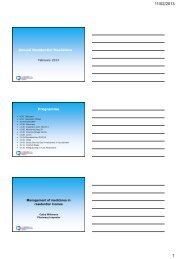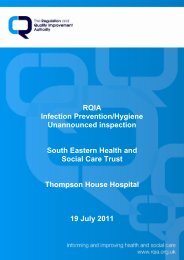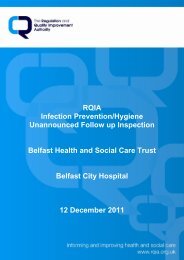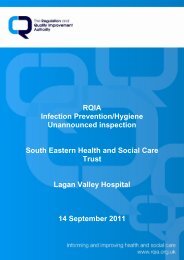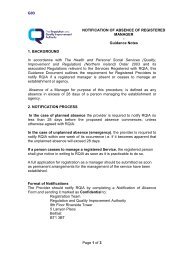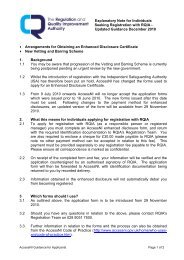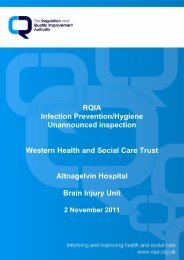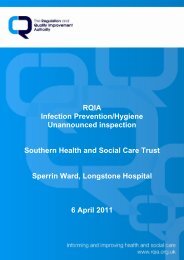Causeway Hospital - 14 June 2012 - Regulation and Quality ...
Causeway Hospital - 14 June 2012 - Regulation and Quality ...
Causeway Hospital - 14 June 2012 - Regulation and Quality ...
You also want an ePaper? Increase the reach of your titles
YUMPU automatically turns print PDFs into web optimized ePapers that Google loves.
RQIA<br />
Infection Prevention/Hygiene<br />
Unannounced inspection<br />
Northern Health <strong>and</strong> Social Care Trust<br />
<strong>Causeway</strong> <strong>Hospital</strong><br />
<strong>14</strong> <strong>June</strong> <strong>2012</strong>
Contents<br />
1.0 Inspection Summary 1<br />
2.0 Background Information to the Inspection Process 5<br />
3.0 Inspections 6<br />
4.0 Unannounced Inspection Process 7<br />
4.1 Onsite Inspection 7<br />
4.2 Feedback <strong>and</strong> Report of the Findings 7<br />
5.0 Audit Tool 8<br />
6.0 Environment 10<br />
6.1 Cleaning 10<br />
6.2 Clutter 12<br />
6.3 Maintenance <strong>and</strong> Repair 12<br />
6.4 Fixture <strong>and</strong> Fittings 12<br />
6.5 Information 13<br />
6.6 Additional Issues 13<br />
7.0 Patient Linen 15<br />
7.1 Management of Linen 15<br />
8.0 Waste <strong>and</strong> Sharps 16<br />
8.1 Waste 16<br />
8.2 Sharps 16<br />
9.0 Patient Equipment 18<br />
10.0 Hygiene Factors 19<br />
11.0 Hygiene Practice 21<br />
11.1 Additional Issues 22<br />
12.0 Key Personnel <strong>and</strong> Information 24<br />
13.0 Summary of Recommendations 25<br />
<strong>14</strong>.0 Unannounced Inspection Flowchart 27<br />
15.0 RQIA Hygiene Team Escalation Policy Flowchart 28<br />
16.0 Action Plan 29
1.0 Inspection Summary<br />
An unannounced inspection was undertaken to <strong>Causeway</strong> <strong>Hospital</strong>,<br />
on the <strong>14</strong> <strong>June</strong> <strong>2012</strong>. The hospital was assessed against the Regional<br />
Healthcare Hygiene <strong>and</strong> Cleanliness st<strong>and</strong>ards <strong>and</strong> the following areas<br />
were inspected:<br />
Elective Surgery<br />
Medical 2<br />
<strong>Causeway</strong> <strong>Hospital</strong> is an acute hospital which offers a range of<br />
services including a 24 hour Accident <strong>and</strong> Emergency Department.<br />
Elective Surgery is a 15 bedded ward, comprising of two patient bed<br />
bays <strong>and</strong> single room ensuite facilities. Medical 2 incorporates 12<br />
medical beds <strong>and</strong> a further 15 beds in the Medical Assessment Unit.<br />
Inspection Outcomes<br />
The results of the inspection showed both wards achieved an overall<br />
compliance level <strong>and</strong> staff are commended for their commitment to<br />
providing a safe <strong>and</strong> clean environment for patients. However<br />
inspectors observed that whilst the environment was generally clean,<br />
further work is required to ensure cleaning <strong>and</strong> monitoring is carried out<br />
especially in areas difficult to access. The trust should continue their<br />
work in providing clutter free ward environments, <strong>and</strong> ensure that there<br />
is an on-going programme of maintenance <strong>and</strong> repair.<br />
Staff knowledge of products used for the cleaning <strong>and</strong> decontamination<br />
of equipment <strong>and</strong> the environment need to improve. Observation of<br />
staff indicated compliance with hygiene <strong>and</strong> infection prevention <strong>and</strong><br />
control practices. However inspectors observed that not all medical<br />
staff adhered to the trust’s dress code policy <strong>and</strong> trust representatives<br />
indicated that this would be brought to the attention of the Medical<br />
Director.<br />
The inspection resulted in 19 recommendations for <strong>Causeway</strong> <strong>Hospital</strong>,<br />
a full list of recommendations is listed in Section 13.<br />
A detailed list of preliminary findings is forwarded to Northern Health<br />
<strong>and</strong> Social Care Trust within <strong>14</strong> days of the inspection to enable early<br />
action on identified areas which have achieved non complaint scores.<br />
The draft report which includes the high level recommendations in a<br />
<strong>Quality</strong> Improvement Plan is forwarded within 28 days of the inspection<br />
for agreement <strong>and</strong> factual accuracy. The draft report is agreed <strong>and</strong> a<br />
completed action plan is returned to RQIA within <strong>14</strong> days from the date<br />
of issue. The detailed list of preliminary findings is available from RQIA<br />
on request.<br />
The final report <strong>and</strong> <strong>Quality</strong> Improvement Plan will be available on the<br />
RQIA website. Reports <strong>and</strong> action plans will be subject to performance<br />
1
management by the Health <strong>and</strong> Social Care Board <strong>and</strong> the Public<br />
Health Agency.<br />
Notable Practice<br />
The inspection identified the following areas of notable practice:<br />
Regular audits are carried out; high impact intervention,<br />
mattresses, h<strong>and</strong> hygiene, environmental cleanliness<br />
In Elective Surgery inspectors were impressed by the<br />
practice <strong>and</strong> knowledge displayed by three nursing<br />
management level students<br />
Participation in protected meal times<br />
The RQIA inspection team would like to thank the staff at <strong>Causeway</strong><br />
<strong>Hospital</strong> for their assistance during the inspection.<br />
The following tables give an overview of compliance scores noted in<br />
areas inspected by RQIA:<br />
Table 1 summarises the overall compliance levels achieved.<br />
Tables 2-7 summarise the individual tables for sections two to seven of<br />
the audit tool as this assists organisation to target areas that require<br />
more specific attention.<br />
Table 1<br />
Ward Elective Surgery Medical 2<br />
Environment 84 85<br />
Patient Linen 97 97<br />
Waste 87 95<br />
Sharps 91 77<br />
Equipment 89 90<br />
Hygiene Factors 98 98<br />
Hygiene Practices 89 93<br />
Total 91 91<br />
Compliant:<br />
85% or above<br />
Partial Compliance: 76% to 84%<br />
Minimal Compliance: 75% or below<br />
2
Table 2<br />
Environment Elective Surgery Medical 2<br />
Reception 82 N/A<br />
Corridors, stairs lift 81 N/A<br />
Public toilets N/A 86<br />
Ward/ department -<br />
general(communal)<br />
76 93<br />
Patient bed area 93 83<br />
Bathroom/washroom 96 94<br />
Toilet 93 N/A<br />
Clinical room/ treatment<br />
room<br />
76 84<br />
Clean utility room 79 79<br />
Dirty utility room 89 83<br />
Domestic store 78 84<br />
Kitchen N/A N/A<br />
Equipment store 77 83<br />
Isolation 94 83<br />
General information 76 80<br />
Total 84 85<br />
Table 3<br />
Linen Elective Surgery Medical 2<br />
Storage of clean linen 94 100<br />
Storage of used linen 100 94<br />
Laundry facilities N/A N/A<br />
Total 97 97<br />
Table 4<br />
Waste <strong>and</strong> sharps Elective Surgery Medical 2<br />
H<strong>and</strong>ling, segregation,<br />
storage, waste<br />
Availability, use, storage of<br />
sharps<br />
87<br />
91<br />
95<br />
77<br />
Compliant:<br />
85% or above<br />
Partial Compliance: 76% to 84%<br />
Minimal Compliance: 75% or below<br />
3
Table 5<br />
Patient Equipment Elective Surgery Medical 2<br />
Patient equipment 89 90<br />
Table 6<br />
Hygiene Factors Elective Surgery Medical 2<br />
Availability <strong>and</strong> cleanliness 99<br />
of WHB <strong>and</strong> consumables<br />
97<br />
Availability of alcohol rub 100 100<br />
Availability of PPE 100 100<br />
Materials <strong>and</strong> equipment<br />
92<br />
for cleaning<br />
95<br />
Total 98 98<br />
Table 7<br />
Hygiene practices Elective Surgery Medical 2<br />
Effective h<strong>and</strong> hygiene<br />
95<br />
procedures<br />
88<br />
Safe h<strong>and</strong>ling <strong>and</strong> disposal 100<br />
of sharps<br />
100<br />
Effective use of PPE 84 100<br />
Correct use of isolation 94 95<br />
Effective cleaning of ward 79 87<br />
Staff uniform <strong>and</strong> work<br />
84<br />
wear<br />
88<br />
Total 89 93<br />
Compliant:<br />
85% or above<br />
Partial Compliance: 76% to 84%<br />
Minimal Compliance: 75% or below<br />
4
2.0 Background Information to the Inspection Process<br />
RQIA’s infection prevention <strong>and</strong> hygiene team was established to<br />
undertake a rolling programme of unannounced inspections of acute<br />
hospitals. The Department of Health Social Service <strong>and</strong> Public Safety<br />
(DHSSPS) commitment to a programme of hygiene inspections was<br />
reaffirmed through the launch in 2010 of the revised <strong>and</strong> updated<br />
version of 'Changing the Culture' the strategic regional action plan for<br />
the prevention <strong>and</strong> control of healthcare associated infections (HCAIs)<br />
in Northern Irel<strong>and</strong>.<br />
The aims of the inspection process are:<br />
to provide public assurance <strong>and</strong> to promote public trust <strong>and</strong><br />
confidence<br />
to contribute to the prevention <strong>and</strong> control of HCAI<br />
to contribute to improvement in hygiene, cleanliness <strong>and</strong> infection<br />
prevention <strong>and</strong> control across health <strong>and</strong> social care in Northern<br />
Irel<strong>and</strong><br />
In keeping with the aims of the RQIA, the team will adopt an open <strong>and</strong><br />
transparent method for inspection, using st<strong>and</strong>ardised processes <strong>and</strong><br />
documentation.<br />
5
3.0 Inspections<br />
The DHSSPS has devised Regional Healthcare Hygiene <strong>and</strong><br />
Cleanliness st<strong>and</strong>ards. RQIA has revised its inspection processes to<br />
support the publication of the st<strong>and</strong>ards which were compiled by a<br />
regional steering group in consultation with service providers.<br />
RQIA's infection prevention/hygiene team have planned a three year<br />
programme which includes announced <strong>and</strong> unannounced inspections<br />
in acute <strong>and</strong> non-acute hospitals in Northern Irel<strong>and</strong>. This will assess<br />
compliance with the DHSSPS Regional Healthcare Hygiene <strong>and</strong><br />
Cleanliness st<strong>and</strong>ards.<br />
The inspections will be undertaken in accordance with the four core<br />
activities outlined in the RQIA Corporate Strategy, these include:<br />
Improving care: we encourage <strong>and</strong> promote improvements in the<br />
safety <strong>and</strong> quality of services through the regulation <strong>and</strong> review of<br />
health <strong>and</strong> social care<br />
Informing the population: we publicly report on the safety,<br />
quality <strong>and</strong> availability of health <strong>and</strong> social care<br />
Safeguarding rights: we act to protect the rights of all people<br />
using health <strong>and</strong> social care services<br />
Influencing policy: we influence policy <strong>and</strong> st<strong>and</strong>ards in health<br />
<strong>and</strong> social care<br />
6
4.0 Unannounced Inspection Process<br />
Trusts receive no advanced notice of the onsite inspection. An email<br />
<strong>and</strong> telephone call will be made by the Chief Executive of RQIA or<br />
nominated person 30 minutes prior to the team arriving on site. The<br />
inspection flow chart is attached in Section <strong>14</strong>.<br />
4.1 Onsite Inspection<br />
The inspection team was made up of four inspectors from RQIA’s<br />
infection prevention/hygiene team. One inspector led the team <strong>and</strong><br />
was responsible for guiding the team <strong>and</strong> ensuring they were in<br />
agreement about the findings reached. Membership of the inspection<br />
team is outlined in Section 12.<br />
The inspection of ward environments is carried out using the Regional<br />
Healthcare Hygiene <strong>and</strong> Cleanliness audit tool. The inspection<br />
process involves observation, discussion with staff, <strong>and</strong> review of some<br />
ward documentation.<br />
4.2 Feedback <strong>and</strong> Report of the Findings<br />
The process concludes with a feedback of key findings to trust<br />
representatives including examples of notable practice identified during<br />
the inspection. The details of trust representatives attending the<br />
feedback session is outlined in Section 12.<br />
The findings, report <strong>and</strong> follow up action will be in accordance with the<br />
Infection Prevention/Hygiene Inspection Process (methodology, follow<br />
up <strong>and</strong> reporting).<br />
The infection prevention/hygiene team escalation process will be<br />
followed if inspectors/reviewers identify any serious concerns during<br />
the inspection (Section 15).<br />
A number of documents have been developed to support <strong>and</strong> explain<br />
the inspection process. This information is currently available on<br />
request <strong>and</strong> will be available in due course on the RQIA website.<br />
7
5.0 Audit Tool<br />
The audit tool used for the inspection is based on the Regional<br />
Healthcare Hygiene <strong>and</strong> Cleanliness st<strong>and</strong>ards. The st<strong>and</strong>ards<br />
incorporate the critical areas which were identified through a review of<br />
existing st<strong>and</strong>ards, guidance <strong>and</strong> audit tools (Appendix 2 of Regional<br />
Healthcare Hygiene <strong>and</strong> Cleanliness st<strong>and</strong>ards). The audit tool follows<br />
the format of the Regional Healthcare Hygiene <strong>and</strong> Cleanliness<br />
St<strong>and</strong>ards <strong>and</strong> comprises of the following sections.<br />
1. Organisational Systems <strong>and</strong> Governance: policies <strong>and</strong><br />
procedures in relation to key hygiene <strong>and</strong> cleanliness issues;<br />
communication of policies <strong>and</strong> procedures; roles <strong>and</strong><br />
responsibilities for hygiene <strong>and</strong> cleanliness issues; internal<br />
monitoring arrangements; arrangements to address issues<br />
identified during internal monitoring; communication of internal<br />
monitoring results to staff.<br />
This st<strong>and</strong>ard is not audited when carrying out unannounced<br />
inspections however the findings of the organisational<br />
system <strong>and</strong> governance at annual announced inspection will<br />
be, where applicable, confirmed at ward level.<br />
2. General Environment: cleanliness <strong>and</strong> state of repair of public<br />
areas; cleanliness <strong>and</strong> state of repair of ward/department<br />
infrastructure; cleanliness <strong>and</strong> state of repair of patient bed area;<br />
cleanliness <strong>and</strong> state of repair of toilets, bathrooms <strong>and</strong><br />
washrooms; cleanliness <strong>and</strong> state of repair of ward/department<br />
facilities; availability <strong>and</strong> cleanliness of isolation facilities;<br />
provision of information for staff, patients <strong>and</strong> visitors<br />
3. Patient Linen: storage of clean linen; h<strong>and</strong>ling <strong>and</strong> storage of<br />
used linen; ward/department laundry facilities<br />
4. Waste <strong>and</strong> Sharps: waste h<strong>and</strong>ling; availability <strong>and</strong> storage of<br />
sharps containers<br />
5. Patient Equipment: cleanliness <strong>and</strong> state of repair of general<br />
patient equipment<br />
6. Hygiene Factors: h<strong>and</strong> wash facilities; alcohol h<strong>and</strong> rub;<br />
availability of personal protective equipment (PPE); availability of<br />
cleaning equipment <strong>and</strong> materials.<br />
7. Hygiene Practices: h<strong>and</strong> hygiene procedures; h<strong>and</strong>ling <strong>and</strong><br />
disposal of sharps; use of PPE; use of isolation facilities <strong>and</strong><br />
implementation of infection control procedures; cleaning of<br />
ward/department; staff uniform <strong>and</strong> work wear<br />
8
Level of Compliance<br />
Percentage scores can be allocated a level of compliance using the<br />
compliance categories below. The categories are allocated as follows:<br />
Compliant<br />
85% or above<br />
Partial compliance 76% to 84%<br />
Minimal compliance 75% or below<br />
Each section within the audit tool will receive an individual <strong>and</strong> an<br />
overall score, to identify areas of partial or minimal compliance to<br />
ensure that the appropriate action is taken.<br />
9
6.0 Environment<br />
STANDARD 2.0<br />
GENERAL ENVIRONMENT<br />
Cleanliness <strong>and</strong> state of repair of public areas; cleanliness <strong>and</strong><br />
state of repair of ward/department infrastructure; cleanliness <strong>and</strong><br />
state of repair of patient bed area; cleanliness <strong>and</strong> state of repair<br />
of toilets, bathrooms <strong>and</strong> washrooms; cleanliness <strong>and</strong> state of<br />
repair of ward/department facilities; availability <strong>and</strong> cleanliness of<br />
isolation facilities; provision of information for staff, patients <strong>and</strong><br />
visitors.<br />
Environment Elective Surgery Medical 2<br />
Reception 82 N/A<br />
Corridors, stairs lift 81 N/A<br />
Public toilets N/A 86<br />
Ward/ department -<br />
general(communal)<br />
76 93<br />
Patient bed area 93 83<br />
Bathroom/washroom 96 94<br />
Toilet 93 N/A<br />
Clinical room/<br />
treatment room<br />
76 84<br />
Clean utility room 79 79<br />
Dirty utility room 89 83<br />
Domestic store 78 84<br />
Kitchen N/A N/A<br />
Equipment store 77 83<br />
Isolation 94 83<br />
General information 76 80<br />
Total 84 85<br />
The above table outlines the findings in relation to the general<br />
environment of the facilities inspected. Overall the wards generally<br />
appeared visibly clean, some issues were identified in relation to<br />
domestic <strong>and</strong> nursing staff cleaning <strong>and</strong> the maintenance <strong>and</strong> repair of<br />
the wards. The findings in respect of the general environment are<br />
detailed in the following sections.<br />
6.1 Cleaning<br />
At the time of the inspection there was evidence to indicate general<br />
compliance with regional specifications for cleaning. The inspectors<br />
observed that in general regular cleaning mechanisms were in place to<br />
prevent the build-up of dust <strong>and</strong> debris, which in turn prevents the<br />
10
uild-up of bacteria <strong>and</strong> subsequently reduces the potential risk for the<br />
transmission of infection.<br />
In the main reception, public toilets <strong>and</strong> corridor leading to the wards<br />
greater attention to detail was required to remove stains on the wall<br />
underneath soap <strong>and</strong> alcohol dispensers <strong>and</strong> to remove dust <strong>and</strong><br />
debris from high, low <strong>and</strong> difficult to reach areas e.g. floor grills <strong>and</strong><br />
skylight.<br />
Comparable findings were noted in both wards such as dirty external<br />
windows, dust on high, low <strong>and</strong> horizontal surfaces, cupboards <strong>and</strong><br />
inside storage units.<br />
In the Elective Surgery Ward dust was noted on the chair pedestals<br />
<strong>and</strong> computers at the nurses’ station. In the domestic store the sluice<br />
<strong>and</strong> equipment sink <strong>and</strong> drainer required cleaning <strong>and</strong> h<strong>and</strong> bags,<br />
foodstuffs <strong>and</strong> cleaning products were stored inappropriately together<br />
in a cupboard. In the patient toilet two paper mache urinals with urine<br />
samples were observed on the floor of the toilet throughout the<br />
inspection <strong>and</strong> the nozzle of the toilet sink taps was grubby.<br />
In Medical 2 limescale was noted on the taps of the sink in Room 6<br />
isolation room, clean utility room <strong>and</strong> the domestic store. In the dirty<br />
utility room there were splashes <strong>and</strong> stains on the interior of the slop<br />
hopper <strong>and</strong> Difficil - S solution was observed on the floor <strong>and</strong> in the<br />
sink. A more robust checking mechanism is required for the cleaning<br />
of isolation rooms as an empty isolation room, terminally cleaned the<br />
night before the inspection, had dust behind the radiator, splash marks<br />
on the mirror, debris in the floor corners <strong>and</strong> adhesive tape residue on<br />
the mattress cover.<br />
Additional Issues<br />
Elective Surgery<br />
Medical 2<br />
A large number of the stationery folders were old <strong>and</strong> worn, with<br />
frayed edges that cannot be effectively cleaned<br />
The deputy ward manager advised that nursing staff do not at<br />
present participate in ward based multidisciplinary<br />
environmental cleanliness audits<br />
Medical staff were observed placing patient notes on the bed<br />
while writing in them, this has the potential for contamination of<br />
the notes<br />
The deputy ward manager advised that nursing staff do not<br />
at present always participate in ward based multidisciplinary<br />
environmental cleanliness audits<br />
11
6.2 Clutter<br />
In both wards the installation of high density storage shows evidence of<br />
an emphasis in providing clutter free environments, this demonstrates<br />
effective utilisation of space. However inspectors observed that in both<br />
wards there was limited storage space available; in some areas<br />
equipment <strong>and</strong> boxes of<br />
supplies were stored on<br />
floors, on top of shelving units<br />
(Picture 1) <strong>and</strong> made work<br />
surfaces cluttered in<br />
appearance e.g. the nurses’<br />
station <strong>and</strong> surrounding area,<br />
dirty utility room. Cluttered<br />
ward environments <strong>and</strong> the<br />
inability to fully access areas<br />
impede effective cleaning.<br />
Picture 1: Storage on floor <strong>and</strong> on<br />
top of shelving units<br />
6.3 Maintenance <strong>and</strong> Repair<br />
Reception, corridors, stairs <strong>and</strong> wards were generally in a good state of<br />
repair however some chipped paintwork <strong>and</strong> damaged skirting,<br />
cupboards, door <strong>and</strong> door frames <strong>and</strong> flooring was observed. Some<br />
ceiling light bulbs were not working.<br />
In Medical 2 bathroom (Room 1) an extraction fan was not present,<br />
there was a strong smell of urine.<br />
6.4 Fixtures <strong>and</strong> Fittings<br />
In both wards inspectors observed some worn, damaged furniture,<br />
fixtures <strong>and</strong> fittings; foot stool, chairs, taps, storage units, shelving <strong>and</strong><br />
bedrails. Cork <strong>and</strong> felt notice boards which cannot be effectively<br />
cleaned were also observed.<br />
In Elective Surgery, bed space privacy curtains <strong>and</strong> window curtains<br />
were poorly hung, some were old <strong>and</strong> worn <strong>and</strong> hooks were not<br />
attached. The outside enamel of the fridge door was chipped <strong>and</strong> the<br />
supplementary drink fridge required defrosting.<br />
12
6.5 Information<br />
In both wards there were no information leaflets available on<br />
Clostridium difficile or posters for nursing staff to reference on the<br />
National Patient Safety Agency (NPSA) cleaning colour coded system<br />
<strong>and</strong> the management of an<br />
inoculation injury. Nursing<br />
cleaning schedules while<br />
available did not detail staff<br />
roles <strong>and</strong> responsibilities <strong>and</strong><br />
in Elective Surgery the<br />
domestic services ward<br />
cleaning manual was not<br />
available. Infection control<br />
information was displayed in<br />
both wards for patients <strong>and</strong><br />
visitors to view (Picture 2).<br />
Picture 2: Infection control information board<br />
In Elective Surgery some posters at the nurses’ station were attached<br />
to surfaces with adhesive tape <strong>and</strong> in Medical 2 a poster on the<br />
segregation of linen was not available for staff.<br />
In both wards fridge temperature checks were recorded in a book. The<br />
layout in the book did not allow staff to record action taken in the event<br />
of a cold chain failure. Inspectors also noted that the fridge door was<br />
open. As Elective Surgery closes at the weekend, fridge temperature<br />
checks are not carried out at the weekend to identify a cold chain<br />
failure. In Medical 2 fridge temperature checks were not consistently<br />
recorded; no records since the 06/06/<strong>2012</strong> <strong>and</strong> there were no<br />
temperature records available for the supplementary drink fridge.<br />
6.6 Additional Issues<br />
Elective Surgery<br />
Medical 2<br />
The number on the resuscitation trolley clip is not recorded as<br />
part of the resuscitation trolley checking process<br />
The emergency trolley checklist had not been consistently<br />
recorded<br />
13
Recommendations<br />
1. The trust should ensure that the systems <strong>and</strong> processes in<br />
place for environmental cleaning provide the necessary<br />
assurance that cleaning is carried out effectively <strong>and</strong> that all<br />
staff are aware of their responsibilities.<br />
2. A robust checking mechanism should be introduced to<br />
ensure that terminal cleaning of isolation rooms is monitored<br />
<strong>and</strong> carried out effectively.<br />
3. Damaged fixtures <strong>and</strong> fittings should be replaced to help<br />
reduce the risk of the spread of infection.<br />
4. The trust <strong>and</strong> staff should work to maintain clutter free ward<br />
environments.<br />
5. The trust should ensure all relevant information leaflets <strong>and</strong><br />
posters are available for patients, visitors <strong>and</strong> staff to<br />
reference <strong>and</strong> use.<br />
6. Detailed nursing cleaning schedules, outlining staff roles <strong>and</strong><br />
responsibilities should further be developed.<br />
7. The trust should ensure a st<strong>and</strong>ard drugs fridge temperature<br />
recording sheet is developed for staff to use.<br />
<strong>14</strong>
7.0 Patient Linen<br />
STANDARD 3.0<br />
PATIENT LINEN<br />
Storage of clean linen; h<strong>and</strong>ling <strong>and</strong> storage of used linen; ward/<br />
department laundry facilities.<br />
Linen Elective Surgery Medical 2<br />
Storage of clean<br />
linen<br />
94 100<br />
Storage of used<br />
linen<br />
100 94<br />
Laundry facilities N/A N/A<br />
Total 97 97<br />
7.1 Management of Linen<br />
Staff within both wards are commended for achieving an overall high<br />
compliance score in this st<strong>and</strong>ard. Issues that if addressed would<br />
achieve full compliance are; a dirty pillowcase on the treatment room<br />
pillow in Elective Surgery <strong>and</strong> a chipped linen skip frame in Medical 2.<br />
In both wards clean linen storage pods were clean <strong>and</strong> clutter free <strong>and</strong><br />
used linen was h<strong>and</strong>led <strong>and</strong> stored correctly.<br />
Recommendations<br />
8. The trust should ensure that clean linen <strong>and</strong> linen<br />
equipment are fit for purpose.<br />
15
8.0 Waste <strong>and</strong> Sharps<br />
STANDARD 4.0<br />
WASTE AND SHARPS<br />
Waste: Effectiveness of arrangements for h<strong>and</strong>ling, segregation,<br />
storage <strong>and</strong> disposal of waste on ward/department<br />
Sharps: Availability, use <strong>and</strong> storage of sharps containers on<br />
ward/department<br />
Waste <strong>and</strong> sharps Elective Surgery Medical 2<br />
H<strong>and</strong>ling, segregation,<br />
87<br />
storage, waste<br />
95<br />
Availability, use, storage of 91<br />
sharps<br />
77<br />
8.1 Waste<br />
In this st<strong>and</strong>ard both wards achieved compliance. The inspection<br />
evidenced that there were arrangements in place for the h<strong>and</strong>ling,<br />
segregation, storage <strong>and</strong> disposal of waste which generally comply<br />
with local <strong>and</strong> regional guidance.<br />
In both wards inspectors observed that waste was segregated <strong>and</strong><br />
disposed of incorrectly e.g. household waste into the black lidded burn<br />
bin.<br />
In Elective Surgery a black waste bag was tied to a domestic trolley<br />
<strong>and</strong> there was no household waste bin in the treatment room. In the<br />
dirty utility room the recycling waste bin required cleaning <strong>and</strong> there<br />
was slight rust on the underside of the clinical waste bin. Inspectors<br />
observed that the ward waste disposal hold was unlocked <strong>and</strong> easily<br />
accessible <strong>and</strong> a clinical waste bag was mixed with laundry bags, this<br />
room required cleaning.<br />
8.2 Sharps<br />
Elective Surgery achieved compliance while Medical 2 achieved partial<br />
compliance in this st<strong>and</strong>ard.<br />
Sharps boxes in use conformed to BS7320 (1990)/UN9291 st<strong>and</strong>ards.<br />
In both wards sharps boxes were assembled correctly; labelled with the<br />
date, locality <strong>and</strong> staff signature. On the Elective Surgery resuscitation<br />
trolley <strong>and</strong> throughout Medical 2 the temporary closure mechanisms on<br />
the sharps boxes were open <strong>and</strong> in Medical 2 the sharps box on the<br />
phlebotomy trolley at the nurses’ station was overfilled with syringes<br />
16
protruding from the open aperture (Picture 3). In Medical 2 the sharps<br />
box on the resuscitation trolley was not empty or secured safely to the<br />
trolley <strong>and</strong> a paper label was taped to the box advising staff not to<br />
remove the box from the trolley, this label impedes staff from<br />
accurately filling out the label on the box.<br />
Picture 3: Syringes protruding from a sharps box<br />
In Medical 2 clean utility room a 22 litre sharps box was bracketed to<br />
the wall. When full the box is heavy <strong>and</strong> difficult to remove from the<br />
bracket, this has potential health <strong>and</strong> safety implications <strong>and</strong> should be<br />
reviewed.<br />
In both wards integral sharps trays, used to store a sharps box <strong>and</strong><br />
equipment when carrying out a procedure were available however staff<br />
were also using paper mache receivers or disposable foil trays, not<br />
recommended as part of the aseptic non touch technique procedure<br />
(ANTT). In Elective Surgery a sharps tray was blood stained.<br />
Recommendations<br />
9. The trust should monitor the implementation of its policies<br />
<strong>and</strong> procedures in respect of the management of waste <strong>and</strong><br />
sharps to ensure that safe <strong>and</strong> appropriate practice is in<br />
place.<br />
10. The trust should ensure that waste bins <strong>and</strong> equipment used<br />
in the management of waste <strong>and</strong> sharps are clean <strong>and</strong> that<br />
waste bins are available <strong>and</strong> fit for purpose.<br />
11. The trust <strong>and</strong> individual staff have a collective responsibility<br />
to ensure that staff knowledge is kept up to date regarding<br />
the safe <strong>and</strong> the correct h<strong>and</strong>ling <strong>and</strong> disposal of waste <strong>and</strong><br />
sharps.<br />
17
9.0 Patient Equipment<br />
STANDARD 5.0<br />
PATIENT EQUIPMENT<br />
Cleanliness <strong>and</strong> state of repair of general patient equipment.<br />
Patient Equipment Elective Surgery Medical 2<br />
Patient equipment 89 90<br />
In this st<strong>and</strong>ard both wards are commended for achieving compliance.<br />
Equipment inspected was generally clean <strong>and</strong> in a good state of repair.<br />
In Elective Surgery a one litre bag of potassium chloride was out of<br />
date; 04/<strong>2012</strong>, this would suggest stock rotation is not routinely carried<br />
out. Inspectors also noted that some staff when questioned were<br />
unaware of the symbol for single use. The fans on the shelving in the<br />
dirty utility room were not covered to protect against the potential for<br />
contamination in a dirty area.<br />
In Medical 2 a patient wash bowl was not stored inverted in the patient<br />
locker resulting in pooling of water in the bowl <strong>and</strong> a single use jug was<br />
observed on the drainer in the dirty utility room, suggesting that it was<br />
being reused by staff. One of the commodes spot checked was<br />
labeled with trigger tape to identify it had been cleaned; a faecal stain<br />
was observed on the side of the seat.<br />
Issues identified in both wards for action were paper labels <strong>and</strong><br />
chipped frames on some equipment.<br />
Recommendations<br />
12. The trust <strong>and</strong> individual staff have a collective responsibility<br />
to ensure that patient equipment is clean, used correctly <strong>and</strong><br />
in a good state of repair.<br />
13. The trust <strong>and</strong> individual staff have a collective responsibility<br />
to ensure that staff knowledge is kept up to date regarding<br />
equipment cleaning.<br />
18
10.0 Hygiene Factors<br />
STANDARD 6.0<br />
HYGIENE FACTORS<br />
H<strong>and</strong> wash facilities; alcohol h<strong>and</strong> rub; availability of PPE;<br />
availability of cleaning equipment <strong>and</strong> materials.<br />
Hygiene Factors Elective Surgery Medical 2<br />
Availability <strong>and</strong> cleanliness<br />
of WHB <strong>and</strong> consumables<br />
99 97<br />
Availability of alcohol rub 100 100<br />
Availability of PPE 100 100<br />
Materials <strong>and</strong> equipment<br />
for cleaning 92<br />
95<br />
Total 98 98<br />
Staff within both wards are commended for achieving an overall high<br />
compliance score in this st<strong>and</strong>ard, with full compliance. No issues<br />
were identified in the availability of alcohol rub <strong>and</strong> PPE.<br />
H<strong>and</strong> washing sinks, fixtures <strong>and</strong> fittings <strong>and</strong> consumables in both<br />
wards were generally clean, working <strong>and</strong> in a good state of repair<br />
(Picture 4). In Elective<br />
Surgery there was no soap<br />
present in the dirty utility room<br />
soap dispenser <strong>and</strong> in<br />
Medical 2 the h<strong>and</strong> washing<br />
sink in Room 1 was splashed.<br />
In Medical 2 the h<strong>and</strong><br />
washing sink in the clean<br />
utility room had a plug, not<br />
recommended as h<strong>and</strong>s<br />
should be washed under<br />
running water.<br />
Picture 4: Typical h<strong>and</strong> washing sink<br />
In both wards a large container of Difficil - S was stored on a work<br />
surface in the unlocked dirty utility room, not in line with COSHH<br />
regulations. This issue is being reviewed by trust staff <strong>and</strong> Difficil - S<br />
suppliers. Inspectors noted that not all nursing staff were aware of the<br />
preparation of Difficil - S for routine cleaning.<br />
Inspectors observed that domestic cleaning equipment was clean <strong>and</strong><br />
in a good state of repair however in Elective Surgery an inverted green<br />
h<strong>and</strong> held bucket was stored inappropriately in the domestic store for<br />
h<strong>and</strong> washing sink.<br />
19
Recommendations<br />
<strong>14</strong>. The trust should ensure that h<strong>and</strong> washing sinks <strong>and</strong><br />
consumables are clean, adequately stocked <strong>and</strong> fit for<br />
purpose.<br />
15. The trust should ensure that all cleaning products are stored<br />
in line with COSHH regulations.<br />
16. The trust <strong>and</strong> individual staff have a collective responsibility<br />
to ensure that staff knowledge is kept up to date in the use of<br />
general cleaning products.<br />
20
11.0 Hygiene Practices<br />
STANDARD 7.0<br />
HYGIENE PRACTICES<br />
H<strong>and</strong> hygiene procedures; h<strong>and</strong>ling <strong>and</strong> disposal of sharps; use<br />
of PPE; use of isolation facilities <strong>and</strong> implementation of infection<br />
control procedures; cleaning of ward/department; staff uniform<br />
<strong>and</strong> work wear.<br />
Hygiene practices Elective Surgery Medical 2<br />
Effective h<strong>and</strong> hygiene<br />
95<br />
procedures<br />
88<br />
Safe h<strong>and</strong>ling <strong>and</strong> disposal 100<br />
of sharps<br />
100<br />
Effective use of PPE 84 100<br />
Correct use of isolation 94 95<br />
Effective cleaning of ward 79 87<br />
Staff uniform <strong>and</strong> work<br />
84<br />
wear<br />
88<br />
Total 89 93<br />
In this st<strong>and</strong>ard both wards achieved compliance, with full compliance<br />
<strong>and</strong> no issues identified in the safe h<strong>and</strong>ling <strong>and</strong> disposal of sharps.<br />
Medical 2 further achieved full compliance in the effective use of PPE.<br />
In both wards staff were aware of the 7 step h<strong>and</strong> hygiene technique for<br />
use with soap or alcohol rub. However in Medical 2 inspectors<br />
observed that medical staff did not always carry out h<strong>and</strong> hygiene<br />
appropriately; prior to donning gloves or after leaving the patient’s<br />
environment, part of the World Health Organisation (WHO) 5 moments<br />
of care. In Medical 2 a registered nurse was not aware that alcohol rub<br />
should not be used for h<strong>and</strong> hygiene when caring for a patient with<br />
Clostridium difficile.<br />
In Elective Surgery there was variation in practice for nursing staff<br />
taking blood pressure; some staff wore gloves <strong>and</strong> aprons while some<br />
staff did not wear any PPE. Inspectors noted that in Medical 2 a<br />
member of medical staff did not wear an apron or put on gloves prior to<br />
a procedure <strong>and</strong> after donning gloves inappropriately touched the<br />
environment, contaminating the gloves.<br />
In both wards the use of isolation facilities was satisfactory however in<br />
the Elective Surgery ward nursing care plans, were not available in the<br />
nursing notes for patients with a potential infection. In Medical 2 there<br />
were inconsistencies in staff documentation for the care bundle for<br />
peripheral intravenous lines.<br />
21
Routine cleaning of equipment between use was observed in both<br />
wards. Although information was available on the preparation of Difficil<br />
- S (Picture 5), nursing staff were unsure of the use of Difficil - S for<br />
cleaning blood spillages <strong>and</strong><br />
the NPSA cleaning colour<br />
coded system. In Elective<br />
Surgery a COSHH folder was<br />
not available at the time of<br />
inspection for nursing or<br />
domestic staff to reference on<br />
disinfectant used at ward<br />
level.<br />
Picture 5: Information on preparation<br />
<strong>and</strong> storage of Difficil - S<br />
In both wards work is required, especially with medical staff, to ensure<br />
adherence to the trust <strong>and</strong> regional dress code policy <strong>and</strong> the concept<br />
of ‘bare below the elbow’. In Elective Surgery a member of staff wore a<br />
green long sleeved cardigan <strong>and</strong> had long hair not tied up above collar<br />
length, a member of medical staff wore a lanyard around their neck <strong>and</strong><br />
a white coat worn by a member of pharmacy required cleaning. In<br />
Medical 2, two medical staff had long hair not tied up above collar<br />
length <strong>and</strong> one wore dangling stoned earrings. In both wards medical<br />
staff were observed wearing a stethoscope around their neck with a roll<br />
of surgical tape hooked over the earpieces. This tape cannot be<br />
effectively cleaned.<br />
11.1 Additional Issues<br />
Medical 2<br />
With the introduction of the regional uniform, staff did not have<br />
name badges <strong>and</strong> patients, visitors <strong>and</strong> other members of staff<br />
were unable to identify staff by name. Trust representatives<br />
advised that this issue has been identified trust wide <strong>and</strong> is to be<br />
addressed.<br />
22
Recommendations<br />
17. The trust <strong>and</strong> individual staff have a collective responsibility<br />
to ensure that h<strong>and</strong> hygiene is carried out in line with WHO<br />
guidance.<br />
18. The trust <strong>and</strong> individual staff have a collective responsibility<br />
to ensure that staff knowledge is kept up to date with regard<br />
to products used for the cleaning <strong>and</strong> decontamination of<br />
equipment <strong>and</strong> the environment.<br />
19. The trust should ensure that all members of staff are familiar<br />
with <strong>and</strong> adhere to the regional dress code policy.<br />
23
12.0 Key Personnel <strong>and</strong> Information<br />
Members of the RQIA inspection team<br />
Mrs E Colgan<br />
Mrs S O'Connor<br />
Mrs M Keating<br />
Mrs L Gawley<br />
- Senior Officer Infection Prevention/Hygiene Team<br />
- Inspector Infection Prevention/Hygiene Team<br />
- Inspector Infection Prevention/Hygiene Team<br />
- Inspector Infection Prevention/Hygiene Team<br />
Trust representatives attending the feedback session<br />
Ms Rebecca Getty - AD Directorate, Support Services<br />
Ms Ann Hamilton - General Manager, Domestic Services<br />
Ms Donna Hanna - Lead Nurse, Medicine<br />
Ms Linda Millar<br />
- Lead Nurse, Surgery<br />
Ms Doreen Reid - Domestic Services Manager<br />
Ms May Cairns<br />
- Infection Prevention <strong>and</strong> Control Nurse<br />
Ms Beth Bolton<br />
- Deputy Ward Manager, Elective Surgery<br />
Ms Barbara Ann Maguire - Deputy Ward Manager, Medical 2<br />
Mr Paul Murray - Deputy Ward Manager, Surgical Unit<br />
Ms Judy McNeill - Deputy Ward Manager, Surgery 1<br />
Supporting documentation<br />
A number of documents have been developed to support the inspection<br />
process, these are:<br />
Infection Prevention/Hygiene Inspection Process (methodology,<br />
follow up <strong>and</strong> reporting)<br />
Infection Prevention/Hygiene Team Inspection Protocol (this<br />
document contains details on how inspections are carried out <strong>and</strong><br />
the composition of the teams)<br />
Infection Prevention/Hygiene Team Escalation Policy<br />
RQIA Policy <strong>and</strong> Procedure for Use <strong>and</strong> Storage of Digital Images<br />
This information is currently available on request <strong>and</strong> will be available<br />
in due course on the RQIA website.<br />
24
13.0 Summary of Recommendations<br />
1. The trust should ensure that the systems <strong>and</strong> processes in place<br />
for environmental cleaning, provide the necessary assurance that<br />
cleaning is carried out effectively <strong>and</strong> that all staff are aware of<br />
their responsibilities.<br />
2. A robust checking mechanism should be introduced to ensure<br />
that terminal cleaning of isolation rooms is monitored <strong>and</strong> carried<br />
out effectively.<br />
3. Damaged fixtures <strong>and</strong> fittings should be replaced to help reduce<br />
the risk of the spread of infection.<br />
4. The trust <strong>and</strong> staff should work to maintain clutter free ward<br />
environments.<br />
5. The trust should ensure all relevant information leaflets <strong>and</strong><br />
posters are available for patients, visitors <strong>and</strong> staff to reference<br />
<strong>and</strong> use.<br />
6. Detailed nursing cleaning schedules, outlining staff roles <strong>and</strong><br />
responsibilities should further be developed.<br />
7. The trust should ensure a st<strong>and</strong>ard drugs fridge temperature<br />
recording sheet is developed for staff to use.<br />
8. The trust should ensure that clean linen <strong>and</strong> linen equipment are<br />
fit for purpose.<br />
9. The trust should monitor the implementation of its policies <strong>and</strong><br />
procedures in respect of the management of waste <strong>and</strong> sharps to<br />
ensure that safe <strong>and</strong> appropriate practice is in place.<br />
10. The trust should ensure that waste bins <strong>and</strong> equipment used in<br />
the management of waste <strong>and</strong> sharps are clean <strong>and</strong> that waste<br />
bins are available <strong>and</strong> fit for purpose.<br />
11. The trust <strong>and</strong> individual staff have a collective responsibility to<br />
ensure that staff knowledge is kept up to date regarding the safe<br />
<strong>and</strong> the correct h<strong>and</strong>ling <strong>and</strong> disposal of waste <strong>and</strong> sharps.<br />
12. The trust <strong>and</strong> individual staff have a collective responsibility to<br />
ensure that patient equipment is clean, used correctly <strong>and</strong> in a<br />
good state of repair.<br />
13. The trust <strong>and</strong> individual staff have a collective responsibility to<br />
ensure that staff knowledge is kept up to date regarding<br />
equipment cleaning.<br />
25
<strong>14</strong>. The trust should ensure that h<strong>and</strong> washing sinks <strong>and</strong><br />
consumables are clean, adequately stocked <strong>and</strong> fit for purpose.<br />
15. The trust should ensure that all cleaning products are stored in in<br />
line with COSHH regulations.<br />
16. The trust <strong>and</strong> individual staff have a collective responsibility to<br />
ensure that staff knowledge is kept up to date in the use of<br />
general cleaning products.<br />
17. The trust <strong>and</strong> individual staff have a collective responsibility to<br />
ensure that h<strong>and</strong> hygiene is carried out in line with WHO<br />
guidance.<br />
18. The trust <strong>and</strong> individual staff have a collective responsibility to<br />
ensure that staff knowledge is kept up to date with regard to<br />
products used for the cleaning <strong>and</strong> decontamination of equipment<br />
<strong>and</strong> the environment.<br />
19. The trust should ensure that all members of staff are familiar with<br />
<strong>and</strong> adhere to the regional dress code policy.<br />
26
Reporting & Re-Audit<br />
Episode of Inspection<br />
Plan Programme<br />
<strong>14</strong>.0 Unannounced Inspection Flowchart<br />
Environmental Scan:<br />
Stakeholders & External<br />
Information<br />
Plan<br />
Programme<br />
Consider:<br />
Areas of Non-Compliance<br />
Infection Rates<br />
Trust Information<br />
RQIA Hygiene Team<br />
Prioritise Themes & Areas for Core Inspections<br />
Prior to Inspection Year<br />
Balance Programme<br />
January/February<br />
Schedule Inspections<br />
Prior to Inspection<br />
Identify & Prepare Inspection Team<br />
Day of Inspection<br />
Inform Trust<br />
Day of Inspection<br />
Carry out Inspection<br />
A<br />
Is there immediate risk<br />
requiring formal escalation?<br />
NO<br />
YES<br />
Invoke<br />
RQIA<br />
IPHTeam<br />
Escalation<br />
Process<br />
Day of Inspection<br />
Feedback Session with Trust<br />
<strong>14</strong> days after<br />
Inspection<br />
28 days after<br />
Inspection<br />
Preliminary Findings<br />
disseminated to Trust<br />
Draft Report<br />
disseminated to Trust<br />
NO<br />
Does assessment of<br />
the findings require<br />
escalation?<br />
YES<br />
Invoke<br />
RQIA<br />
IPHTeam<br />
Escalation<br />
Process<br />
A<br />
<strong>14</strong> days later<br />
Signed Action Plan<br />
received from Trust<br />
Within 0-3 months<br />
Is a Follow-Up required?<br />
Based on Risk Assessment/key<br />
indicators or Unsatisfactory <strong>Quality</strong><br />
Improvement Plan (QIP)?<br />
YES<br />
Invoke<br />
Follow-Up<br />
Protocol<br />
Process enables<br />
only 1 Follow-Up<br />
NO<br />
Open Report published to Website<br />
YES<br />
Is Follow-Up<br />
satisfactory?<br />
NO<br />
DHSSPS/HSC<br />
Board/PHA<br />
PHA<br />
27
15.0 Escalation Process<br />
RQIA Hygiene Team: Escalation Process<br />
B<br />
RQIA IPH<br />
Team<br />
Escalation<br />
Process<br />
Concern / Allegation / Disclosure<br />
Inform Team Leader / Head of Programme<br />
MINOR/MODERATE<br />
Has the risk been<br />
assessed as Minor,<br />
Moderate or Major?<br />
MAJOR<br />
Inform key contact <strong>and</strong> keep a record<br />
Inform appropriate RQIA Director <strong>and</strong> Chief Executive<br />
Record in final report<br />
Inform Trust / Establishment / Agency<br />
<strong>and</strong> request action plan<br />
Notify Chairperson <strong>and</strong><br />
Board Members<br />
Inform other establishments as appropriate:<br />
E.g.: DHSSPS, RRT, HSC Board, PHA,<br />
HSENI<br />
Seek assurance on implementation of actions<br />
Take necessary action:<br />
E.g.: Follow-Up Inspection<br />
28
16.0 Action Plan<br />
Recommendations<br />
Reference<br />
Number<br />
Recommendations<br />
1 The trust should ensure that the systems<br />
<strong>and</strong> processes are in place for<br />
environmental cleaning, provide the<br />
necessary assurance that cleaning is<br />
carried out effectively <strong>and</strong> that all staff are<br />
aware of their responsibilities.<br />
Designated<br />
Department<br />
Domestic/Estates<br />
Action required<br />
Domestic Management <strong>and</strong> staff<br />
have job descriptions which clarify<br />
roles <strong>and</strong> responsibilities.<br />
St<strong>and</strong>ards of cleaning are<br />
monitored on a daily, monthly <strong>and</strong><br />
annual basis.<br />
Date for<br />
Completion<br />
Timescale<br />
Actioned<br />
Audits are multi disciplinary ie;<br />
involve domestic services,<br />
estates, nursing <strong>and</strong> infection<br />
prevention control staff <strong>and</strong><br />
managers.<br />
2 A robust checking mechanism should be<br />
introduced to ensure that terminal cleaning<br />
of isolation rooms is monitored <strong>and</strong> carried<br />
out effectively.<br />
3 Damaged fixtures <strong>and</strong> fittings should be<br />
replaced to help reduce the risk of the<br />
spread of infection.<br />
Domestic <strong>and</strong><br />
Infection<br />
Prevention Control<br />
Team & Nursing<br />
Nursing/Domestic/<br />
Estates<br />
High cleaning is carried out by<br />
Estates services on rolling basis<br />
Rooms are checked by nursing<br />
staff following a clean. Checks<br />
are also carried out IPC team.<br />
Issues are raised immediately<br />
with Domestic Services manager<br />
<strong>and</strong> where necessary staff are<br />
retrained in procedures.<br />
Staff are aware of their<br />
responsibilities to identify <strong>and</strong><br />
damage <strong>and</strong> of the process for<br />
actioning repair/replacement by<br />
Estates staff<br />
Actioned<br />
Checks<br />
ongoing post<br />
cleans<br />
Actioned<br />
Ongoing<br />
29
Reference<br />
Number<br />
Recommendations<br />
4 The trust <strong>and</strong> staff should work to maintain<br />
clutter free ward environments.<br />
5 The trust should ensure all relevant<br />
information leaflets <strong>and</strong> posters are<br />
available for patients, visitors <strong>and</strong> staff to<br />
reference <strong>and</strong> use.<br />
Designated<br />
Department<br />
Nursing Staff<br />
Corporate<br />
Communications/<br />
Heads of<br />
Departments/Lead<br />
Nurses<br />
Action required<br />
Nursing <strong>and</strong> Domestic staff<br />
continue to maintain a clutter free<br />
environment.<br />
The ward manager <strong>and</strong> Deputy<br />
managers monitor daily.<br />
Trust is continuously reviewing<br />
leaflet content <strong>and</strong> availability<br />
through the analysis of patient<br />
<strong>and</strong> client experience<br />
questionnaires<br />
Date for<br />
Completion<br />
Timescale<br />
Daily<br />
Monitoring in<br />
place<br />
Actioned<br />
6 Detailed nursing cleaning schedules,<br />
outlining staff roles <strong>and</strong> responsibilities<br />
should further be developed.<br />
7 The trust should ensure a st<strong>and</strong>ard drugs<br />
fridge temperature recording sheet is<br />
developed for staff to use.<br />
8 The trust should ensure that clean linen<br />
<strong>and</strong> linen equipment are fit for purpose.<br />
Nursing<br />
Pharmacy<br />
Linen<br />
Services/Nursing<br />
Availability of leaflets is also<br />
monitored at ward level during<br />
audits <strong>and</strong> walkabouts<br />
Lead nurses will support ward<br />
managers to ensure that cleaning<br />
schedules have been developed<br />
<strong>and</strong> implemented where<br />
necessary<br />
Recording sheet to be developed<br />
<strong>and</strong> issued to all relevant areas<br />
Ward managers/head of service<br />
to monitor usage<br />
Linen services manager is<br />
responsible for ensuring clean<br />
linen is fit for purpose when<br />
issued. Ward staff are responsible<br />
for identifying items that need<br />
repair/disposal.<br />
September<br />
<strong>2012</strong><br />
September<br />
<strong>2012</strong><br />
September<br />
<strong>2012</strong><br />
Staff to be reminded of their<br />
responsibilities<br />
30
Reference<br />
Number<br />
Recommendations<br />
9 The trust should monitor the<br />
implementation of its policies <strong>and</strong><br />
procedures in respect of the management<br />
of waste <strong>and</strong> sharps to ensure that safe<br />
<strong>and</strong> appropriate practice is in place.<br />
Designated<br />
Department<br />
Domestic/Nursing/<br />
Estates Services<br />
Action required<br />
All staff will be reminded at team<br />
meetings of policy on waste<br />
disposal. Ward Manager <strong>and</strong><br />
Deputies will monitor waste<br />
management <strong>and</strong> sharps disposal<br />
taking corrective action as<br />
required<br />
Date for<br />
Completion<br />
Timescale<br />
Monthly<br />
meetings<br />
Daily/As<br />
required<br />
Discussed at<br />
Safety<br />
Briefings<br />
10 The trust should ensure that waste bins<br />
<strong>and</strong> equipment used in the management of<br />
waste <strong>and</strong> sharps are clean <strong>and</strong> that waste<br />
bins are available <strong>and</strong> fit for purpose.<br />
11 The trust <strong>and</strong> individual staff have a<br />
collective responsibility to ensure that staff<br />
knowledge is kept up to date regarding the<br />
safe <strong>and</strong> the correct h<strong>and</strong>ling <strong>and</strong> disposal<br />
of waste <strong>and</strong> sharps.<br />
Domestic/<br />
Nursing<br />
Domestic/<br />
Infection<br />
Prevention<br />
Control/Estates<br />
waste officer<br />
Estates waste manager provides<br />
training on regular basis.<br />
Domestic Supervisors <strong>and</strong> Ward<br />
Managers to identify at<br />
Daily/Monthly audits any unclean<br />
bins or bin needing replaced.<br />
Cleaning carried out immediately<br />
<strong>and</strong> bin replaced<br />
Waste <strong>and</strong> sharps management<br />
is monitored during ward/service<br />
based environmental cleanliness<br />
audits. Any examples of poor<br />
practice are reported <strong>and</strong><br />
corrective action taken.<br />
Actioned <strong>and</strong><br />
process is<br />
ongoing<br />
Actioned<br />
Ongoing<br />
audits<br />
12 The trust <strong>and</strong> individual staff have a<br />
collective responsibility to ensure that<br />
patient equipment is clean, used correctly<br />
<strong>and</strong> in a good state of repair.<br />
Domestic/Nursing<br />
Staff are aware that noncompliance<br />
to policies regarding<br />
this area could result in<br />
disciplinary action<br />
Domestic <strong>and</strong> Nursing staff are<br />
aware of their respective<br />
responsibilities in relation to<br />
equipment cleanliness, usage <strong>and</strong><br />
state of repair. Equipments found<br />
to be below st<strong>and</strong>ard are isolated<br />
<strong>and</strong> either cleaned again, sent for<br />
Actioned<br />
31
Reference<br />
Number<br />
Recommendations<br />
13 The trust <strong>and</strong> individual staff have a<br />
collective responsibility to ensure that staff<br />
knowledge is kept up to date regarding<br />
equipment cleaning.<br />
<strong>14</strong> The trust should ensure that h<strong>and</strong> washing<br />
sinks <strong>and</strong> consumables are clean,<br />
adequately stocked <strong>and</strong> fit for purpose.<br />
15 The trust should ensure that all cleaning<br />
products are stored in line with COSHH<br />
regulations.<br />
16 The trust <strong>and</strong> individual staff have a<br />
collective responsibility to ensure that staff<br />
knowledge is kept up to date in the use of<br />
general cleaning products.<br />
Designated<br />
Department<br />
Domestic/Nursing<br />
Domestic<br />
Services/Estates<br />
Services<br />
Action required<br />
repair or declared obsolete if<br />
damaged beyond repair.<br />
Domestic <strong>and</strong> Nursing staff are<br />
aware of which items of<br />
equipment they are responsible<br />
for cleaning at through schedules<br />
held at ward level. St<strong>and</strong>ard of<br />
cleaning is monitored through<br />
general daily observations <strong>and</strong><br />
also as part of internal IPCEH<br />
audits. Where concerns are<br />
identified staff are retained in<br />
procedures.<br />
Domestic services staff have<br />
been trained in the requirements<br />
for cleaning <strong>and</strong> stock of h<strong>and</strong><br />
basins.<br />
Estates services are carry out a<br />
replacement programme of any<br />
sinks found to be unfit for purpose<br />
Domestic Services Domestic supervisors will check<br />
on a daily basis as part of the<br />
daily observational checklist that<br />
all cleaning products are stored in<br />
Domestic/<br />
Nursing<br />
line with COSHH regulations.<br />
Training is given to all relevant<br />
staff in the usage <strong>and</strong> storage of<br />
cleaning products as part of their<br />
induction.<br />
Additional training is provided if<br />
products change<br />
Date for<br />
Completion<br />
Timescale<br />
Actioned<br />
Actioned<br />
Ongoing<br />
Actioned<br />
Ongoing<br />
Actioned<br />
32
Reference<br />
Number<br />
Recommendations<br />
17 The trust <strong>and</strong> individual staff have a<br />
collective responsibility to ensure that h<strong>and</strong><br />
hygiene is carried out in line with WHO<br />
guidance.<br />
18 The trust <strong>and</strong> individual staff have a<br />
collective responsibility to ensure that staff<br />
knowledge is kept up to date with regard to<br />
products used for the cleaning <strong>and</strong><br />
decontamination of equipment <strong>and</strong> the<br />
environment.<br />
19 The trust should ensure that all members of<br />
staff are familiar with <strong>and</strong> adhere to the<br />
regional dress code policy.<br />
Designated<br />
Department<br />
Domestic/<br />
Nursing/<br />
Other disciplines<br />
Nursing/Other<br />
disciplines<br />
All disciplines<br />
Action required<br />
H<strong>and</strong> hygiene monitored at ward<br />
level. Performance contained<br />
within Trust Board reports. Staff<br />
found to be non-compliant are<br />
retrained<br />
Relevant directors will issue a<br />
reminder to staff regarding this<br />
important issue<br />
All staff to be reminded of<br />
regional dress code policy <strong>and</strong><br />
monitoring of adherence factored<br />
into audit process <strong>and</strong> general<br />
service management<br />
Date for<br />
Completion<br />
Timescale<br />
Actioned<br />
August <strong>2012</strong><br />
Actioned<br />
Any revisions to current policy are<br />
issued on a cascade basis via<br />
directors for discussion with staff<br />
at team/ward/departmental<br />
meetings<br />
33


